This is what it looks (and feels) like when you’re standing under 10,000+ crows, coming home to roost. I shot the video well after dusk, so I had to crank exposure up in iMovie, causing pixel issues. Still … you’ll get the idea.
This occurs every dusk in Bothell, Washington, when crows from Seattle, Snohomish and other parts in between fly to their nightly roost.
I had never seen a roost of this magnitude, and I can’t say I was prepared for it. We were told to get a vantage point from a parking garage, top floor, which we did. We watched probably a thousand or so crows fly in from the south and head toward some trees north of us, which was spectacular enough.
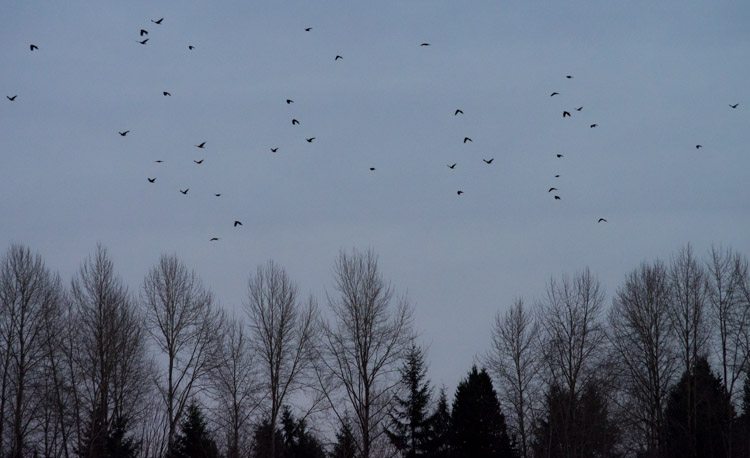
The “River of Crows,” as some call it, fizzled out overhead, so we moved a bit farther north to where we saw them land. I couldn’t imagine what we would see next. Our river was but a trickle compared to the cacophony of crows landing, perching, flushing again and again … then meeting new crows flying in by the hundreds. Using The Birds as a clichéd comparison doesn’t even come close to describing how it feels to stand below an airborne nation of crows.
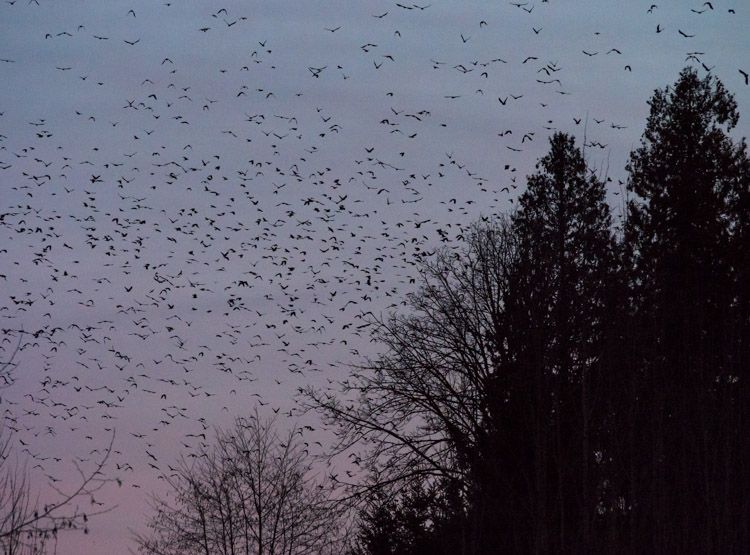
The fly-in rivaled, for me, the first time I watched a fleet of Tundra Swans fly over the Sacramento Delta. The crows’ sudden flushing from the trees was like a Snow Goose blast, as birds take to the air en masse.
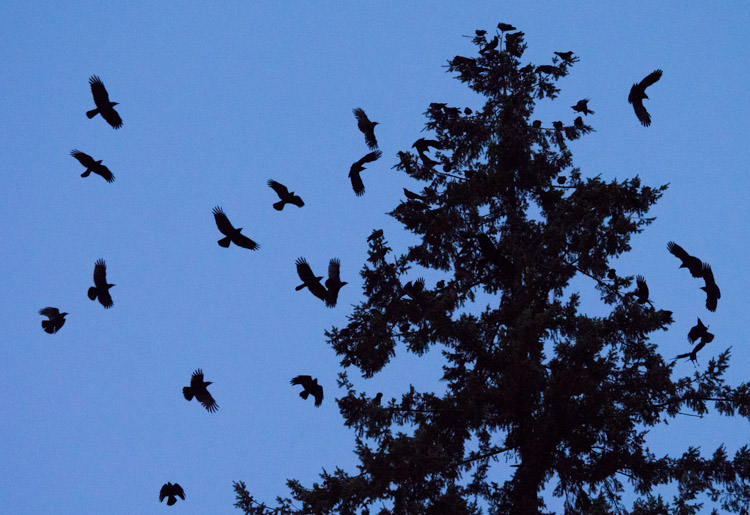
We followed them to the road below where they now swarmed the rooftops.
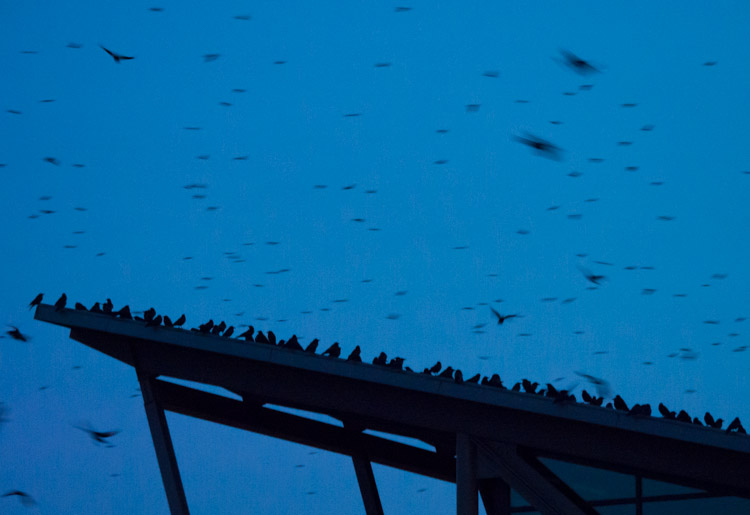
From the rooftops, they descended at once to an adjacent soccer pitch (depicted in the video above).
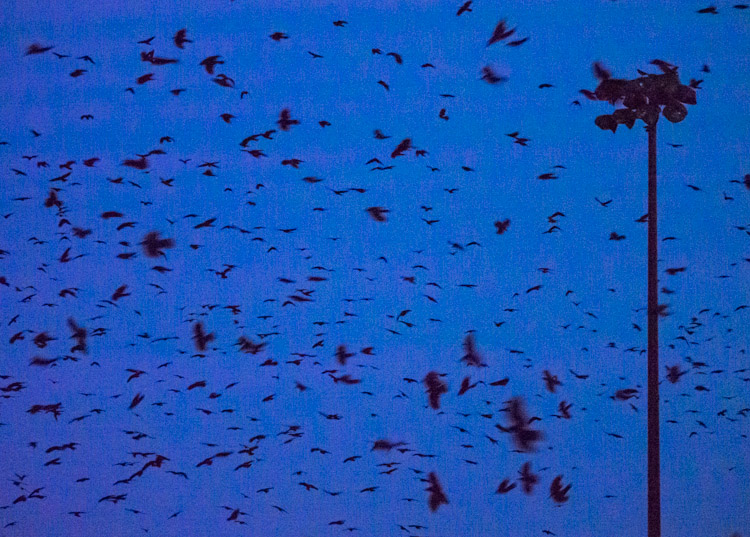
By now, it was too dark for any photos of the field, although I wish I could have photographed this segment. I was shooting at ISO 10,000 and still getting pitch-black images.
The crows were packed body to body on the pitch. After a few minutes, they started walking — or rather, swaggering the way crows do — toward the far edge of the field. We presumed they were headed for the trees below where the field leveled off. It was too dark to see their final roosting spot and we didn’t want to venture in that direction and disturb their nightly ritual.
I found this video lecture by University of Washington crow expert, John Marzluff. I’ve mentioned Marzluff’s work previously in my blog posts when discussing crows. The video is long — an hour plus — but below, I’ve marked the times for various points in the discussion … just in case you want to skip through to the particular topics that interest you.
I love crows, that’s no secret — from the first crow we ever rescued and tried to rehabilitate, when I was just a schoolgirl. I love and appreciate these birds even more now, after being lucky enough to witness this phenomenon. There are no words nor lenses powerful enough to capture the visceral essence of these events when we experience them. I can only hope that my retention and memory is as sharp as a crow’s (see minute 48:30 in the video below for a discussion of crow brains and complexities).
- 0 to 10 minutes: The roosting behavior of crows at UW Bothell Campus
- 10:00 – Caledonian Crows’ complex problem solving and insight
- 12:30 – Risk-taking behavior of ravens and crows
- 13:40 – Delinquent behavior (beer drinking, opioid receptors, etc)
- 14:20 – Conflict/”warfare”
- 14:50 – Mischievous behavior
- 16:30 – “Hitchcock,” the windshield-wiper-stealing raven
- 18:20 – Corvid language and a corvid’s practical joke on dogs
- 20:25 – Crow funerals
- 22:08 – Intelligence and brain structure
- 30:00 – Cultural co-evolution of crows and other species
- 31:18 – Recognition by crows of human faces
- 35:10 – Mask studies (recognition) at UW campus
- 45:15 – PET scans of crow brains and emotional responses
- 48:30 – PET scan imagery
- 54:07 – Corvids and “gifting” to humans

I do consider us quite lucky to have been spared their globby “gifts” from the sky! 😉
We were, the automobile wasn’t. Or, as you call it … “our birding car” (suitably worn in for the travels).
HUGH,,,ANY place where theres a large population of people, your going to see gods cleanup crew waiting, as they know dinner will be on the table here shortly,so you few who are survivors,do not let the animals in the cities harm these crows,their waiting to clean up the dead bodies,and they won’t leave till every bone is picked clean,.its the LORDS way of preventing the spread of desase……………………
Thanks for the videos. I’ve been the watching the lecture from UW and really like the term “cultural carrying capacity”, as it seems to refer to how humans behave when there is a mutual, psychological awareness and connection with large numbers of urbanised birds in cities.
My only experience with crows was in Florida, and there are no crows in Puerto Rico. We have Grackles (which are not corvids, but icterids), and are highly intelligent too. Why there are no crows in P.R. is a good question. The Cuban Crow (Corvus nasicus) is one of four species of crow that occur on a few islands in the Caribbean which is closely related to the White-necked Crow (C. leucognaphalis) and Jamaican Crow (C. jamaicensis). There is a Palm Crow (Corvus palmarum) in the Dominican Republic, but is more related to the Fish Crow (Corvus ossifragus) from Florida.
The White-necked crow (C. leucognaphalis) is the one that became extinct in P.R. (I now read), and it’s classified as Vulnerable (VU) on the IUCN (International Union for Conservation of Nature) Red list. It only thrives in the Dominican Republic and Haiti; with the massive deforestation there, it is rapidly declining.
I’m glad the American Crow is doing well. My grandfather trained a crow (years ago in Illinois when I was a kid), and taught him tricks that even got him published on the Joliet, Ill newspaper. I was too young to understand, but he kept the crow as a pet, which I now find a bit disgusting, considering they are such social birds.
Maria, I read this and then your addendum about your grandfather’s story. I know we also have to keep in mind how awareness of wildlife medicine and ethics have changed over the years. For instance, one of the first birds I helped rescue was a crow — a beautiful fledgling my mother saved from marauding, free-roaming dogs. The parents cawed overhead, frantic, but my mother felt she had no choice but to take the youngster because of her injured wing. We could not, at the time, find a wildlife expert in our area. We got help from a medical nurse on treating the injury and so forth. As kids, we had no idea we were doing anything besides “good” by taking her in and caring for her. I think that was probably a common sentiment and I do think it still persists. At the wildlife hospital, we’d sometimes get animals in that were cared for at home, often inexpertly, but by people whose intentions were good although misinformed. I cringe now thinking about our own ineptitude, even with the best ambitions to do right by the little crow. When our fledgling did not ultimately survive, I lost it emotionally. I still get choked up for my own culpability in that event, even though it was so many years ago and I was just a kid.
In this case my grandfather was successful in both accounts, he (apparently) saved him, and was able to cut-off the emotional tie also. Great point.
Based on what you wrote, your grandfather did a stellar job in helping this crow! One lucky bird, not only for the care he received but also for being in the hands of a person who understood the bird’s needs over his own. I think it’s a wonderful story.
My account of my grandfather’s crow was actually rectified by my aunt the other night. I was too harsh on him by virtue of my own ignorance.
My grandfather found the crow as a chick alone in the snow and nursed him into young adulthood. He trained him to do many tricks, but eventually the crow recognised another crow’s call, and began to get restless. My grandfather knew then that the pet-relationship was going to be a big no-no, since crows have a prodigious bonding with one another in the wild. As soon as he heard the other crow’s call, out in the wild, he had to release him.
Your video is amazing Ingrid, I turned my volume up loud enough to hear the wings. That must have been a mind bending sight to see and hear!!
I have a soft spot for corvids, they are highly intelligent and sometimes down right comical. They always amaze and enchant me.
All of this is fascinating – As usual your photos are a delight! In your second image it appears that crow flight is a lot like snowflakes. From observing the positioning of their wings… No two are alike. Awesome diversity in what looks like it would be 10,000 instances of “sameness”.
Their gifts to humans… The heart-tart… Love it! 😉
What an amazing spectacle!
Where I live in Burnaby, there is this phenomena that happens every evening, where thousands of crows fly into the trees of one area, though it is becoming more and more overgrown with industrial buildings they continue.
You can see them from all over the city around 4 to 5pm heading to the location.
Many people want them culled because of the mess they leave on the buildings and cars, but thankfully nothing like that has happened. They were there first you know!!! Right.
Well it is nice to know that if they were there first they usually feed on dead things or garbage. Must say a lot for the area and the people living there. Maybe it smells like coming into Oakland off the John Daly bridge!
So … what’s your point? And if you going to diss Oakland, you might want to get your geographical references right.
[…] 10,000 Crows and Counting […]
[…] Photo credit and for more info: Ingrid Taylar at https://www.thewildbeat.com/2013/01/02/10000-crows-and-counting/ […]